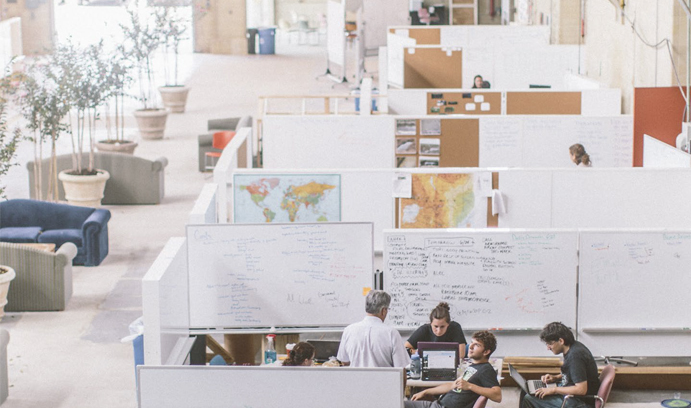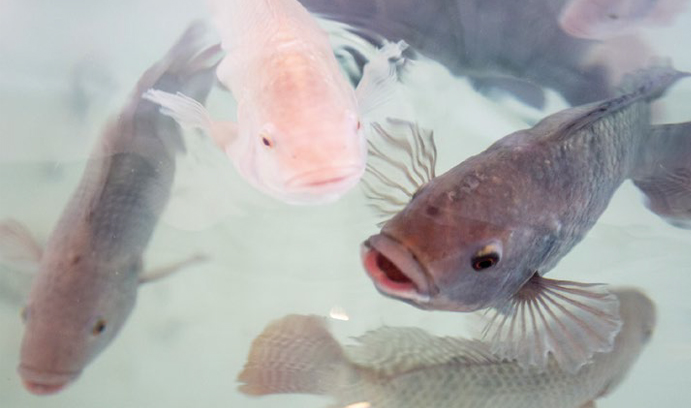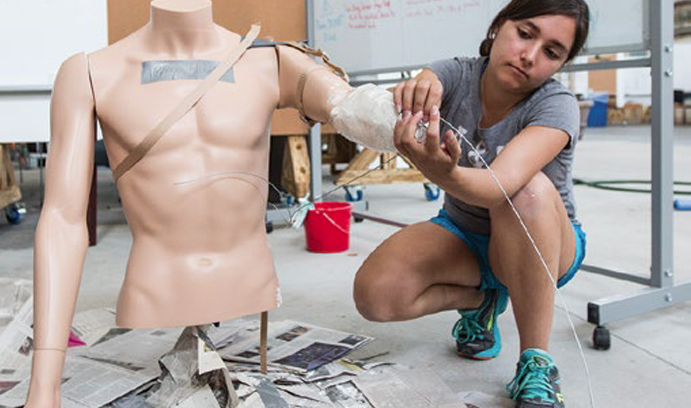The Freedom to Ask Their Own Questions

In the space dedicated to Lehigh's groundbreaking Mountaintop Initiative, engineering students are teaming up with peers from across campus to take on challenges of their own design.

Mountaintop students are designing a low-cost system for raising fish and produce through aquaponics.

Bioengineer Arielle Weiner ’16 and her team spent the summer designing a prosthetic hand that is cost-efficient and can be used in developing countries.
Building C on Lehigh’s Mountaintop Campus is a hulking edifice that wears with surprising grace a sleek skin of glass and gridded concrete.
The former Bethlehem Steel building has an airy, open interior that is rimmed with color-coded piping and conduits and other postmodern decorative motifs.
Lehigh was able to lay claim to and renovate Building C thanks to a $20 million gift from Urban Outfitters founder Scott Belair ’69.
During the summer of 2014, teams of students conducted open-ended venture research projects there based on their ambitions for changing the world. Implicit in this Mountaintop Initiative are questions about what a 21st century education should look like, what the world will need from university graduates, and how graduates will serve and find their place in the world.
The whiteboards in Building C’s workspaces sport the jumbled and overlapping scrawls of many hands. Tables are cluttered with prototypes, debris and the detritus of hastily taken meals. The mood is freewheeling, with students milling over to nearby workstations to chat or work through problems with members of other groups. There is widespread evidence of caffeine consumption.
“This is a different idea of teaching,” says William Best, professor of practice in mechanical engineering and mechanics and co-director of Lehigh’s IDEAS (Integrated Degree in Engineering, Arts and Sciences) program. “The students are selected for the program based on merit but also on whether they can fully take advantage of this unique environment. It’s completely unstructured; students create their own deliverables. They’re not encumbered by classroom or curriculum. The faculty are here as advocates, but in a way we are kind of meaningless. I met with one group and couldn’t get a word in edgewise.”
Richard Weisman, professor of civil and environmental engineering and, like Best, a faculty adviser, is working with several Mountaintop groups. “The students are great learners; they’re independent learners. They have invented the projects, and they have a lot of freedom, even freedom to fail.
“When I have a course during the regular semester with a deliverable at the end, I want to make sure the students have the sense of accomplishing that goal. I may let them go down a blind alley a bit, but then reel them back in.
“At Mountaintop, we don’t reel them in.”
The program gives the concept of interdisciplinary study more than lip service, says Weisman.
“When we used to say ‘interdisciplinary,’ it meant a structural engineer and a foundation engineer working together. Here it’s engineering with others from across the academic spectrum. Our social science and humanities students might question how they can contribute to an engineering problem, but they do.”
Aquaponics in a distillery vat
For example, Emily Poche ’16, who majors in international relations and francophone studies, is working with Alex Derish ’15 (finance), Kimberly Hetrick ’15 (environmental engineering) and Jeff Schwartz ’14 (civil engineering) on an aquaponics project, growing produce and raising tilapia inside an old 1,000-liter distillery vat filled with water.
On their white board, the students have jotted the words, “Give a man a box of food and he’ll eat for a day. Teach a man aquaponics, and he’ll eat for a lifetime.”
Aquaponics—from aquaculture (raising fish in tanks) and hydroponics (cultivating plants in water)—was invented in the 1970s, says Schwartz.
“No one has taken it quite where it can go. You can get an acre of growth out of a shipping container, it’s not dependent on weather and the produce we’re getting is amazing.”
“This technology could revolutionize the way people feed themselves,” says Poche. “I could teach anyone to build and use this system, and that’s what I would like to be doing, humanitarian engineering. It’s really cool.”
Schwartz outlined how it works. “We have single-sex tilapia in a tank. Our only input is fish food. The fish excrete soluble and insoluble waste. We harness the soluble waste, essentially ammonia, and put it through a bacterial process to create nitrates, which nourish the produce. The plants have natural systems to purify the water, which is then re-circulated back into the system.”
The project’s faculty advisers are Weisman and Mark Orrs, professor of practice in political science and director of Lehigh’s sustainable development program.
Poche, who wondered at first what she had to offer the enterprise, is running the public relations effort and seeking support. Those less-versed in-- hard science, she says, contribute in other ways as well. She recounted draining one of the project’s draft beds.
“We had a problem with the pump. The tank is heavy and there’s 300 gallons of water running through it. Our engineers were trying to fashion a siphon, and then devise a lever system to tip the tank. Finally Alex, our finance major, looks and says, ‘Let’s just take a bucket and dip it in from the top.’ Sometimes you can get too sophisticated and overlook something simple.
“On the other hand, I’m writing the manual teaching people how to use and troubleshoot the system. Someone from a tech perspective can say: ‘Well this is good, but you totally missed what to do if there’s a fish kill.’”
A prosthetic for Cambodia
Other Mountaintop projects also require crossing academic frontiers. The broader sociological, environmental and other concerns often aren’t obvious, and it takes inclination, research and creative thought to find them.
Zakaria Hsain ’17 (mechanical engineering), Danielle Taitt ’16 (science, technology and society/economics) and Arielle Weiner ’16 (bioengineering) are designing a prosthetic hand that is cost-efficient and can be used in developing countries. “It has to be affordable, but also preserve performance,” says Hsain. “To reduce maintenance, we’re making it body-powered with no electronics.”
The students are producing the prosthetics on a 3D printer in their cubicle. Numerous prior efforts litter their work table.
“We’ve wired belts and attachments to the prosthetic,” says Weiner. “It’s controlled by shoulder movements to make it open or close. We’re focusing now on a power grip and pinching, so it requires two specific types of movement.”
Taitt focuses on the sociological research. “There is a need for prosthetics in Cambodia because of land mines. Some of the things we found out really influenced our design. We started out with a kind of bionic, three-finger hand. But we learned there is discrimination against the disabled there, so we went to a five-finger design with a glove to fit over it so the wearer can appear as able-bodied as possible.”
“Some things we couldn’t do,” says Hsain. “Many amputees work in agriculture, so the hand has to have high tolerances for lifting. We first put the thumb on the side, to make it realistic, but the most useful grips involve the thumb being vertically opposed to the fingers. It’s a more secure grip.
“There are many more angles we had to look at as we got into the project, so there’s a lot of brainstorming. Something always comes up and you have to make a decision.”
Everyone has a different perspective,” says Taitt. “That puts a lot of options on the table from the start, and gives you recourse if the first attempt doesn’t work out.”
Combating Vitamin A deficiency
Vitamin A deficiency, which affects 250 million children in 88 countries, can cause blindness and other maladies. The World Health Organization estimates that as many as 500,000 children lose their sight each year due to the condition. Half of them die within a year of becoming blind.
Sebastian Boberg ’14 (finance) and Corrina Lucini ’14 (bioengineering) are taking on the problem with help from Akshaya Shankar, a Ph.D. candidate in chemical engineering.
“It’s pretty easy to fix,” says Boberg. “If you have a known population, you can introduce rice enriched with vitamin A. But resources are limited so you have to figure out where to put them.”
There is no cheap, noninvasive, effective test for the deficiency, says Boberg. “There are tests that are too expensive for broad use, or cheap tests that require feedback from the person you’re testing, which won’t work for infants and very young children.”
“Our idea is for a handheld sensor and disposable, inexpensive chips,” says Lucini. “It would use carbon nanotubes and field-effect transistors to reflect a signal.”
The students envision taking a small blood sample with a tiny lancet, placing the blood on a chip and feeding it to the sensor. The sensor would measure the conductivity in the sample, which correlates to the level of vitamin A.
“The protein that carries vitamin A in the bloodstream is conductive,” Lucini says. “Carbon nanotubes are perfect because they’re so small. Each tube is a ring one atom thick. Any change to any atoms on the tubes will make a big difference, so it’s very sensitive.”
Lucini reflects on her summer at Mountaintop. “I love having the application to look forward to. The kind of education we’re getting here is making us well-rounded and preparing us to deal with things we haven’t faced before. I think the world is moving towards people who have that kind of versatility and agility.”
Safe access to water
Manraj Matharu ’15 (bioengineering) and Greg Jacobs ’15 (electrical engineering) are designing a wind turbine that can be built in Africa with local materials and can pump water from shallow wells. They are also producing an instruction manual using only illustrations that can be easily understood.
“We’re focusing now on Kenya and East Africa,” says Matharu. “They’re near Lake Victoria, there’s high wind and temperatures are low at night. In addition, there are few obstructions, and we have connections in Kenya who will help us get started.
“There are two kinds of wells in that area. The first are the wells that people dig themselves. That means sending someone down a hole and hauling out sand and rock to the 50-foot depth where the water is. It’s dangerous. On average, there are two fatalities for every well dug this way, not including children who may fall in after it’s built.
“The other kind of well is built by aid organizations. They go down 1,500 feet and give you perfect access to water but they are cemented in place so you can’t access the system for repair if a part breaks.
“We want to analyze the wells constructed by aid organizations to see if there’s a pattern to the failures, and if there’s a fix we can come up with. We’ve seen pictures of playing kids hanging off the handles of these wells. Maybe part of the answer is something simple, like an effective community education project.”
This project, says Best, exemplifies the multifaceted role of the 21st-century engineer.
“So much of engineering today has to do not only with the ethical and social impact of technology,” he says, “but also with learning how to ask the right questions, and having the freedom to find the significant questions.”
“All of this work we are doing is totally applicable,” says Matharu, “and we’re doing it because we want to do it. That makes all the difference.”
Posted on:


